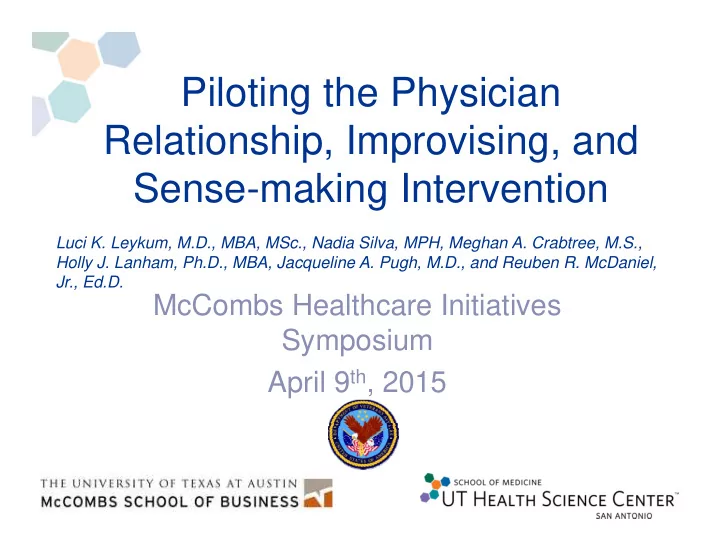

Piloting the Physician Relationship, Improvising, and Sense-making Intervention Luci K. Leykum, M.D., MBA, MSc., Nadia Silva, MPH, Meghan A. Crabtree, M.S., Holly J. Lanham, Ph.D., MBA, Jacqueline A. Pugh, M.D., and Reuben R. McDaniel, Jr., Ed.D. McCombs Healthcare Initiatives Symposium April 9 th , 2015
Presentation Outline • PRISm – Background and Purpose • Intervention setting, participants, and context • Preliminary Results – Team Observations and Attending Interviews • Preliminary Conclusions
PRISm: Background & Purpose • How do we systematically improve hospitalized patient care? • By improving how providers: – Relate to each other – Make sense of what is happening – Improvise in uncertain situations
Intervention Setting Audie L. Murphy Memorial VA Hospital San Antonio, TX • 220-bed acute care facility • Part of the South Texas Veterans Health Care System • Teaching Hospital affiliated with UTHSCSA
Intervention Participants • Four Inpatient General Medicine teams, consisting of: – 1 Faculty Attending Physician – 1 PGY-2/3 Resident – 2 PGY-1 Interns – 2 to 3 Medical students – Pharmacist and/or pharmacy students
Intervention Context Daily Attending Rounds Rounding Pattern Description Pattern Gravity Starting at the highest floor and moving down Geography Starting on a particular unit and moving to contiguous units Intern by Intern Rounding on one intern’s patients first and then the other’s Running the Rounding in the team room, going down the list of Board patients in the order they are listed Patient-driven Based on patients’ clinical needs
Intervention Context Daily Attending Rounds Rounding Pattern Description Pattern Gravity Starting at the highest floor and moving down Geography Starting on a particular unit and moving to contiguous units Intern by Intern Rounding on one intern’s patients first and then the other’s Running the Rounding in the team room, going down the list of Board patients in the order they are listed Patient-driven Based on patients’ clinical needs
Intervention Context Daily Attending Rounds Rounding Pattern Description Pattern Gravity Starting at the highest floor and moving down Geography Starting on a particular unit and moving to contiguous units Intern by Intern Rounding on one intern’s patients first and then the other’s Running the Rounding in the team room, going down the list of Board patients in the order they are listed Patient-driven Based on patients’ clinical needs
Intervention Context Daily Attending Rounds Rounding Pattern Description Pattern Gravity Starting at the highest floor and moving down Geography Starting on a particular unit and moving to contiguous units Intern by Intern Rounding on one intern’s patients first and then the other’s Running the Rounding in the team room, going down the list of Board patients in the order they are listed Patient-driven Based on patients’ clinical needs
Intervention Context Daily Attending Rounds Rounding Pattern Description Pattern Gravity Starting at the highest floor and moving down Geography Starting on a particular unit and moving to contiguous units Intern by Intern Rounding on one intern’s patients first and then the other’s Running the Rounding in the team room, going down the list of Board patients in the order they are listed Patient-driven Based on patients’ clinical needs
P hysician R elationship, I mprovising and S ense m aking intervention • 3 Key Components: – Briefings before rounds – Debriefings after rounds – STICC for individual patient discussions
The STICC Framework STICC Definition element Situation “What are we dealing with?” Task “What do we think we should do?” Are specific steps explicitly discussed? Intent “ Why are we doing it?” Explicit discussion of why team is deciding on a plan Concern “ What are we watching for?” Discussion of potential complications, things to consider Calibrate “What don’t we know?” “What do we do if…?” Includes contingency statements and more-than-1-step-ahead thinking.
PRISm: Implementation & Assessment
PRISm: Implementation & Assessment
PRISm: Implementation & Assessment
PRISm: Implementation & Assessment
PRISm: Implementation & Assessment
PRISm Preliminary Results Rounding Patterns and Patient Load
PRISm Preliminary Results Percent Patient Discussions containing STICC
PRISm Preliminary Results Attending Interviews
Preliminary Conclusions • Integrating PRISm into rounds: • Is feasible and easily adaptable • Encourages patient-driven rounding patterns • Enables mindful patient discussions • May benefit from a more structured orientation • Can augment other tools, e.g. SOAP
Recommend
More recommend